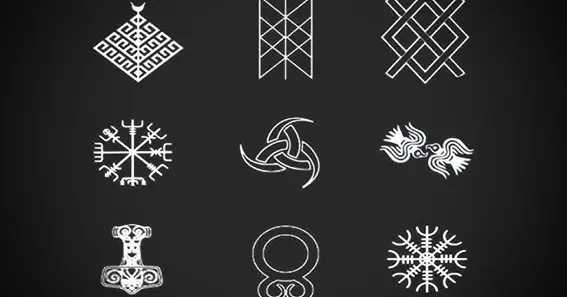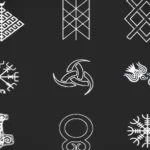The Vikings were known for their deep connection to symbols, many of which carried significant cultural, religious, and personal meanings. From representing their beliefs in the gods to invoking protection in battle, Viking symbols are not just historical artifacts but are embedded in Norse mythology and lore. These symbols often appeared in Viking art, jewelry, and runestones, giving us insight into the values of the Norse people.
Prominent Viking Symbols and Their Meanings
- Mjölnir (Thor’s Hammer): Perhaps the most famous Viking symbol, Mjölnir represents protection, strength, and the power of Thor, the god of thunder. It was often worn as an amulet to invoke Thor’s protection against evil forces and enemies.
- Yggdrasil (The Tree of Life): Yggdrasil is the immense ash tree that connects the nine realms of Norse cosmology, including Asgard (home of the gods) and Midgard (home of humans). It symbolizes the interconnectedness of life and fate.
- Valknut: Known as the “knot of the slain,” the Valknut is associated with warriors who died in battle. This symbol is linked to Odin, the god of war and death, and is often seen on ancient carvings and runestones.
- The Helm of Awe (Ægishjálmr): This magical symbol was believed to provide protection and inspire fear in enemies. Warriors would often inscribe it on their foreheads or shields before battle to gain courage and safeguard themselves from harm.
- The Web of Wyrd: Representing the concept of fate and destiny, the Web of Wyrd is a lesser-known but powerful symbol in Norse mythology. It suggests that past actions, present decisions, and future outcomes are all intricately connected, forming the threads of one’s life.
Also Read : Bastian Sobtzick Age: How Old Is The Talented Musician?
FAQ
- What is the significance of Mjölnir (Thor’s Hammer)?
- Mjölnir symbolizes strength, protection, and the power of Thor. Vikings wore it to invoke Thor’s protection during battles and other challenges.
- What does the Valknut symbolize?
- The Valknut represents the afterlife and is associated with warriors who have died in battle. It is closely linked to Odin, the god of war and death.
- What is the Helm of Awe used for?
- The Helm of Awe was believed to protect the wearer and instill fear in their enemies. It was commonly used by warriors for courage and protection in battle.
- What does Yggdrasil represent in Viking mythology?
- Yggdrasil represents the interconnectedness of all life and the cosmos. It is the central tree in Norse mythology, connecting the nine realms.
- What is the meaning of the Web of Wyrd?
- The Web of Wyrd symbolizes fate and destiny. It reflects the interconnectedness of past, present, and future events, suggesting that every action influences the course of one’s life.
Also Read : Celina Powell Born: A Look Into The Life Of The Social Media Star
By exploring the rich symbolism of the Vikings, we gain a deeper understanding of how their beliefs shaped their world. These symbols remain relevant today, influencing art, literature, and spiritual practices across the globe.










